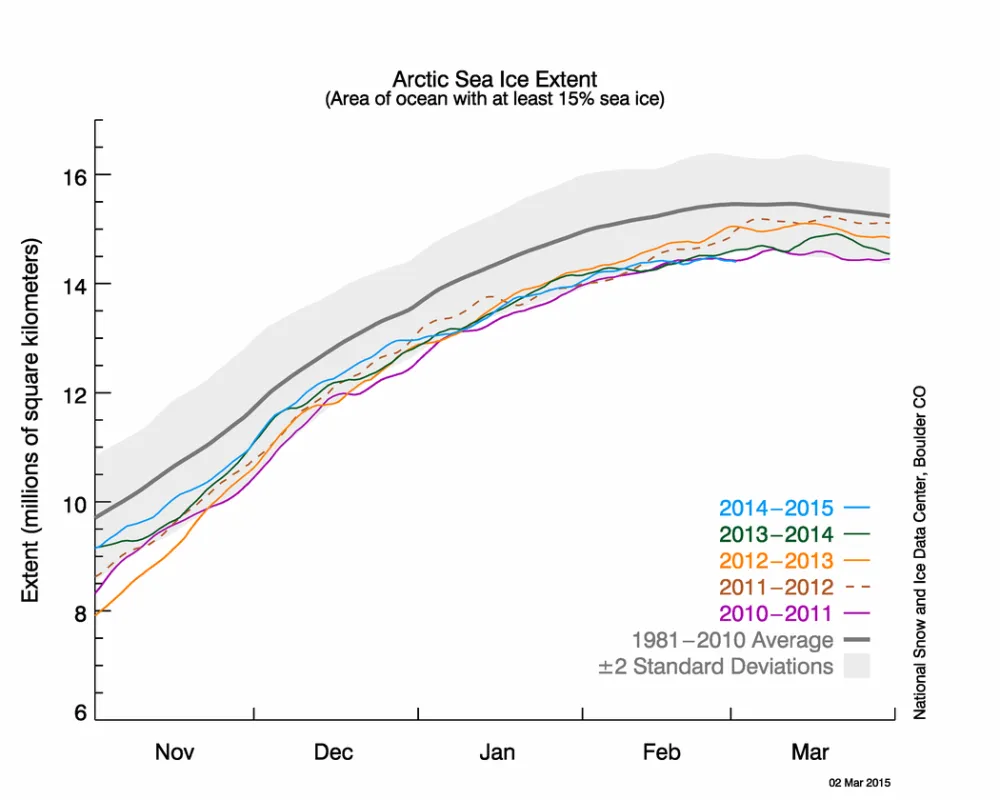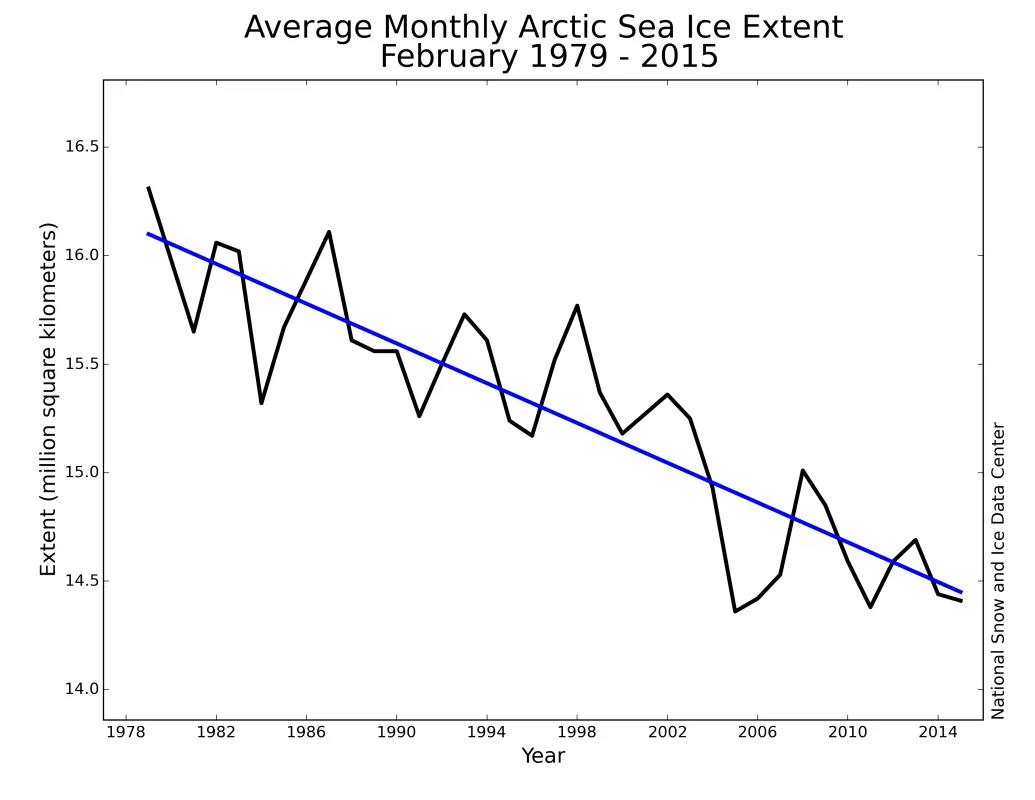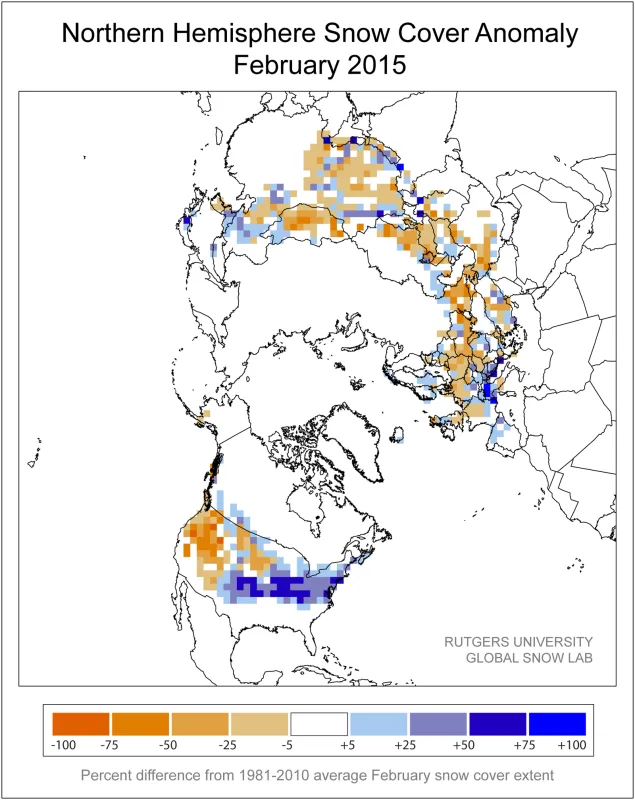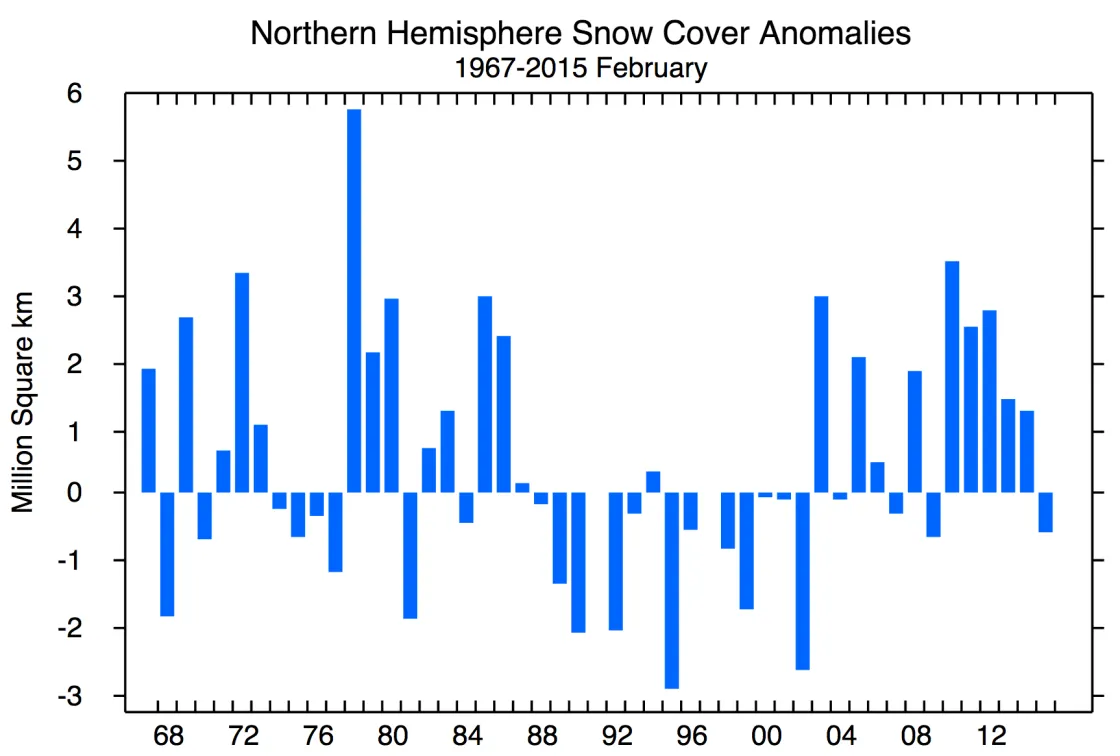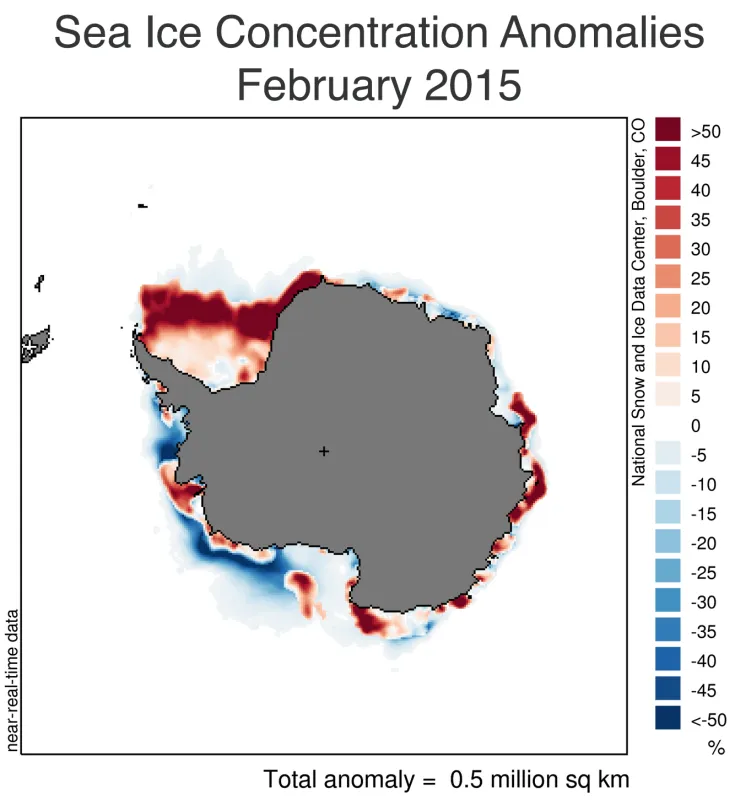Arctic sea ice extent continues to track well below average, but it is still unclear whether March will see an increase in ice, or establish a record low maximum. Regionally, Arctic ice extent is especially low in the Sea of Okhotsk and the Bering Sea. In the Antarctic, sea ice shrank to the fourth highest minimum in the satellite record.
Overview of conditions
Arctic sea ice extent in February averaged 14.41 million square kilometers (5.56 million square miles). This is the third lowest February ice extent in the satellite record. It is 940,000 square kilometers (362,900 square miles) below the 1981 to 2010 long-term average of 15.35 million square kilometers (5.93 million square miles). It is also 50,000 square kilometers (19,300 square miles) above the record low for the month observed in 2005.
With the Arctic Ocean completely ice covered, the remaining areas of potential new ice growth are limited to the margins of the pack in the northern Pacific and northern Atlantic. Sea ice extent is below average across the entire sea ice margin, most prominently along the Pacific sectors. A small region of above-average ice extent is located near Newfoundland and the Canadian Maritime Provinces.
The Arctic maximum is expected to occur in the next two or three weeks. Previous years have seen a surge in Arctic ice extent during March (e.g., in 2012, 2014). However, if the current pattern of below-average extent continues, Arctic sea ice extent may set a new lowest winter maximum.
Conditions in context
Arctic sea ice extent increased by 429,000 square kilometers (165,600 square miles) during the month of February. This gain was slightly less than the average for the month. While low extent for the Arctic as a whole was largely driven by conditions in the Sea of Okhotsk and the Bering Sea, extent was also slightly below average along the Barents Sea and parts of the East Greenland Sea.
February 2015 compared to previous years
The monthly average Arctic sea ice extent for February was the third lowest in the satellite record. Through 2015, the linear rate of decline for February extent is 2.9% per decade.
Hot Bering(s)
The low ice extent in the Bering Sea and Sea of Okhotsk is linked to unusually warm conditions in the area. February air temperatures at the 925 hPa level were as much as 4 to 6 degrees Celsius (7 to 11 degrees Fahrenheit) above average in the northern Bering Sea, easternmost Siberia, and Sea of Okhotsk.
While these localized hotspots are in part driven by the low sea ice extent and the resulting large heat fluxes from the open water to the atmosphere, they are seen to be part of a broad area of unusually warm conditions extending across most of northern Eurasia, across Alaska, and into the western part of the United States. In contrast, cold and snowy conditions have persisted across the eastern half of North America. Broadly speaking, these opposing patterns of warmth and cold, along with low ice extent in the Sea of Okhotsk and Bering Sea, can be linked to an unusual jet stream pattern, with the jet lying north of its usual location over Eurasia and the North Pacific (meaning that warm air extends further north than is usual), and then plunging southwards over eastern North America.
Snow cover
This unusual jet stream pattern is clearly manifested in the pattern of Northern hemisphere snow cover for February. Snow extent was well above average over the northeastern U.S. However, the western U.S. and Northern Rockies saw less snow cover than average, especially along the Pacific coast where it has been particularly warm and severely dry. While the Tibetan Plateau saw a somewhat more extensive snow cover than average in December and January, extent for Tibet and Eurasia as a whole was below average in February. Higher-than-average snow cover in the eastern U.S. expanded and became more pronounced this month as well. All of these are continuations of the basic pattern seen in December and January, although the pattern of extensive snow over the northeastern U.S. became more pronounced this month. The low snow cover extent in much of Eurasia is consistent with the warmer-than-average conditions there as described above.
Seasonal Antarctic minimum reached
Antarctic sea ice extent reached its annual minimum, dipping to 3.58 million square kilometers (1.38 million square miles) on February 20. This is the fourth highest summer minimum extent on record, trailing behind 2008 (3.75 million square kilometers or 1.44 million square miles, highest), 2013, and 2003. The 2014 Antarctic minimum ranked the fifth highest (3.54 million square kilometers or 1.36 million square miles). For the month as a whole, February 2015 has the sixth highest ice extent (3.8 million square kilometers or 1.46 million square miles). The sea ice extent trend for February for 1979 to 2015 shows an increase of 5.0% per decade. However, Antarctica’s sea ice extent is highly variable. As recently as 2011, Antarctic sea ice extent was at near-record low levels for the summer minimum.
Nevertheless, the recent series of high-ice-extent minima is part of a remarkable recent uptick in extent year-round for Antarctica, dominated by extensive ice in both the Weddell Sea (south of Africa) and the Ross Sea (south of New Zealand). Sea ice in the eastern Weddell Sea presently extends several hundred kilometers further north and east of its typical extent, while ice extent in the Ross Sea is presently near average. The debate continues regarding the cause of the recent Antarctic trends, but the best explanation so far involves a combination of strengthening low pressure in the eastern Ross Sea (the Amundsen Sea Low) and the eastern Weddell Sea, and a persistently positive phase of the Southern Annular Mode. The freshening of surface seawater around Antarctica may also play a role.
Global sea ice trends
Claire Parkinson of NASA recently presented the global average (Arctic plus Antarctic) trend in sea ice extent for the period 1979 to 2013. Overall, global sea ice has declined, despite the positive trend in Antarctic extent. The annual average trend is -35,000 square kilometers (-13,500 square miles) per year, or about -1.5% per decade. The strong Arctic decline in September leads to the largest magnitude monthly trend for global sea ice in that month, at -68,000 square kilometers (-26,300 square miles) per year, or -2.6% per decade. See the NSIDC FAQ on global sea ice here.
Further reading
Parkinson, C. L. 2014. Global sea ice coverage from satellite data: annual cycle and 35-year trends. Journal of Climate, doi: 10.1175/JCLI-D-14-00605.1.

